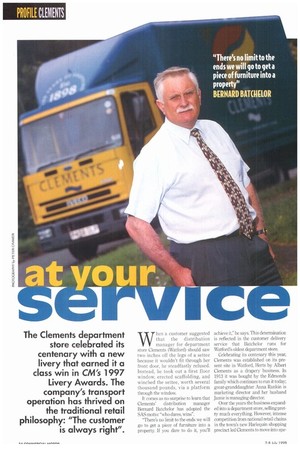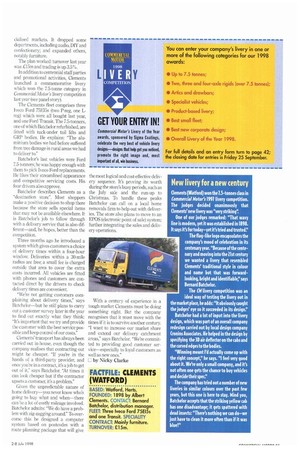PROFILE CLEMENTS
Page 36

Page 37

If you've noticed an error in this article please click here to report it so we can fix it.
The Clements department store celebrated its centenary with a new livery that earned it a class win in CM'S 1997 Livery Awards. The company's transport operation has thrived on the traditional retail philosophy: "The customer is always right".
hen a customer suggested that the distribution manager for department store Clements (Watford) should saw two inches off the legs of a settee because it wouldn't fit through her front door, he steadfastly refused. Instead, he took out a first floor window, erected scaffolding, and winched the settee, worth several thousand pounds, via a platform through the window.
It comes as no surprise to learn that Clements' distribution manager Bernard Batchelor has adopted the SAS motto; "who dares, wins".
"There's no limit to the ends we will go to get a piece of furniture into a property. If you dare to do it, you'll achieve it," he says. This determination is reflected in the customer delivery service that Batchelor runs for I,Vatford's oldest department store.
Celebrating its centenary this year, Clements was established on its present site in Watford, Herts by Albert Clements as a drapery business. In 1913 it was bought by the Edmonds family which continues to run it today; great-granddaughter Anna Rankin is marketing director and her husband Jamie is managing director.
Over the years the business expanded into a department store, selling pretty much everything. However, intense competition from national retail chains in the town's new Harlequin shopping precinct led Clements to move into spe cialised markets. It dropped some departments, including audio, DIY and confectionery; and expanded others, notably furniture.
The plan worked: turnover last year was .£15m and trading is up 3.5%.
In addition to centennial staff parties and promotional activities, Clements launched a commemorative livery which won the 7.5-tonne category in Commercial Motor's livery competition last year (see panel story).
The Clements fleet comprises three Iveco Ford 75E15s (two P-reg, one Lreg) which were all bought last year, and one Ford Transit. The 7.5-tonners, one of which Batchelor refurbished, are fitted with tuck-under tail lifts and GRP bodies. He explains: "The aluminium bodies we had before suffered from tree damage in rural areas we had to deliver to."
Batchelor's last vehicles were Ford 75-tonners; he was happy enough with them to pick Iveco Ford replacements. He likes their streamlined appearance and competitive servicing costs. His four drivers also approve.
Batchelor describes Clements as a "destination store". Most shoppers make a positive decision to shop there because the store sells special items that may not be available elsewhere. It is Batchelor's job to follow through with a delivery service that is also different—and, he hopes, better than the competition.
Three months ago he introduced a system which gives customers a choice of delivery times within a four-hour window. Deliveries within a 30-mile radius are free; a small fee is charged outside that area to cover the extra costs incurred. All vehicles are fitted with phones and customers are contacted direct by the drivers to check delivery times are convenient.
"We're not getting customers complaining about delivery times," says Batchelor—but he still plans to carry out a customer survey later in the year to find out exactly what they think: "It's important that we try and provide the customer with the best service possible and keep control of our costs."
Clements' transport has always been carried out in-house, even though the company realises that contracting out might be cheaper. "If you're in the hands of a third-party provider, and once you're in a contract, it's a job to get out of it," says Batchelor. "At times it can look cheaper but if the contractor upsets a customer, it's a problem."
Given the unpredictable nature of home delivery—you never know who's going to buy what and when—there can be a lot of costly mileage involved. Batchelor admits: "We do have a problem with zig-zagging around." To overcome this he designed a computer system based on postcodes with a route planning package that will give
the most logical and cost-effective delivery sequence. It's proving its worth during the store's busy periods, such as the July sale and the run-up to Christmas. To handle these peaks Batchelor can call on a local home removals firm to help out with deliveries. The store also plans to move to an EPOS (electronic point of sale) system; further integrating the sales and delivery operations.
With a century of experience in a tough market Clements must be doing something right. But the company recognises that it must move with the times if it is to survive another century. "I want to increase our market share and extend our delivery catchment areas," says Batchelor. "We're committed to providing good customer service—especially to loyal customers as well as new ones."
L by Nicky Clarke FACTFILE: CLEMENTS (WATFORD) BASED: Watford, Herts. FOUNDED: 1898 by Albert Clements. CONTACT: Bernard Batchelor, distribution manager. FLEET: Three Iveco Ford 75E15s and one Transit. SPECIALITY CONTRACT: Mainly furniture. TURNOVER: E15m.
New livery for a new century
Clements (Wad ord) won the-LS-tonnes class in Commercial Motor's 1991 livery competition. The judges decided unanimously that Clements' new livery was "very striking': One of our judges remarked: "That wavy line is modern, yet it was established in 1898. It says it's for today—yet it's tried and trusted!'
The flag-like logo encapsulates the company's mood of celebration in its centenary year. "Because of the centenary and moving into the list century we wanted a livery that resembled Clements' traditional style in colour and name but that was forwardlooking, bright and identifiable;' says Bernard Batchelor,
The CM livery competition was an ideal way of testing the livery out in the market place, he adds: "It obviously caught the judges' eye so it succeeded in its design!'
Batchelor had a lot of input into the livery design, which was part of an overall company redesign carried out by local design company Cronins Associates. Ile helped in the design by specifying the 3D air deflector on the cabs and the curved edges to the bodies.
"Winning meant I'd actually come up with the right concept," he says. "I feel very good about it. We're only a small company, and it's not often one gets the chance to buy vehicles and decide their spec."
The company has tried out a number of new liveries in similar colours over the past few years, but this one is here to stay. Mind you, Batchelor accepts that the striking yellow cab has one disadvantage; it gets spattered with dead insects: "There's nothing we can do—we just have to clean it more often than if it was blue!"












































































































